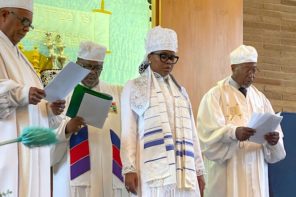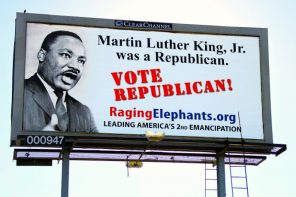What inspired you to write Chosen People? What sparked your interest?
When I was in college I was interested in the similarities between Jewish and Black nationalisms, and began to learn Jewish and African American histories at Stanford University with Clayborne Carson, George Fredrickson, Sylvia Wynter, Mark Mancall, Arnie Eisen, and Tudor Parfitt.
A chance encounter led me to visit the Original Hebrew Israelites of Dimona, Israel, and the experience was so powerful that I set out to study the antecedents of Black Israelite movements. At that time, Shlomo Levy, a Columbia University graduate student who was himself the son of one of the leading figures of the New York Israelite community, had begun to work with the Schomburg Center of the New York Public Library to collect papers from a dozen or so Black Israelite synagogues. I wrote an honors thesis on a small part of that collection, and then returned in graduate school to use the rest.
Working towards my doctorate at UCLA I was fortunate enough to study Black Atlantic religions with Donald Cosentino, and African American and West Indian histories with Brenda Stevenson, Gary Nash, and Bobby Hill. I was also inspired by seminars I took with Carlo Ginzburg, Peg Jacob, Lynn Hunt, Henry Yu, and others. I wanted to thickly describe African American Judaism from microhistorical, Black Atlantic, and African American Studies perspectives.
The question of “authenticity” that had dominated the accounts of so many white Jews was of little interest to me. What had gone missing in the limited literature on the topics was an attempt to tell the story of Black Israelites as an instance of African American history (in the hemispheric sense, including the West Indies), and an attempt to write Black Israelites into the larger stories of American religion and of Black Atlantic religions.
You describe a variety of fascinating (and largely unknown) figures in American religious history. Which one of them fascinated you the most?
Prophet William Saunders Crowdy stars in two chapters and is a largely unknown but remarkable figure who deserves to be on a postage stamp for the impact he had on U.S. religion and culture. But without a doubt, I was most fascinated by Rabbi Wentworth Arthur Matthew. That is because I had access to sources at the Schomburg and in newspapers over half a century that allowed me to clearly see Rabbi Matthew’s religious evolution, and his polycultural bricolage of his own Israelite tradition combining Holiness-based Israelite churches, Judaism, conjuring, West Indian festivals, Central European occult practices, and freemasonry. Although Matthew tried his best to hide this religious bricolage, his papers offer a rare opportunity to see how new religions are made.
Is there anything you had to leave out?
Tons. I came to see Black Israelites as being very closely related to Black Muslims. Not only was there overlap between the groups’ memberships, but it was not uncommon for groups to blend elements of both Judaism and Islam in the 1920s, as in the 1970s.
I think African American adoption of both religions are variants of Black thought about “the East,” and deserve to be thought of as Black forms of Orientalism—not in a pejorative sense, but in an affirmative and romantic sense. So at one point the book was at least twice as long, before I decided that the Islam/Orientalism piece needed to be a book of its own.
Even then, the Black Israelites book continued for five more chapters concerning interactions and race relations between white and Black Jews during the Civil Rights and Black Power eras. Thankfully, Oxford University Press’ readers reined me in, and I was left with the much more compact, and much more readable text as it stands today, which focuses on the period from the nineteenth century to the 1930s.
Some scholars may wonder how large these groups were, especially since African American Protestantism is assumed to be so large and powerful. How do you respond to those searching to answer that ever-elusive problem of how “representative” these groups and leaders were?
One of the joys of writing this book has been watching its focus expand. I started with the papers of New York Black Israelite synagogues—small groups to be sure. But the clues I found in those sources soon led me to many more numerous groups.
The first black Israelite churches, founded at the turn of the twentieth century, were mega churches with two to three thousand members each in New York and Philadelphia—not to mention affiliates across the Midwest, South, West Indies, and even South Africa.
Israelite ideas were popular in the Holiness movement, and played an indispensable role in the evolution of Pentecosalism, the most numerous Christian movement of the twentieth century. I could find important antecedents in the Anglo-Israelite, who had representatives both here and in Britiain, and even make a cameo in E.P. Thompson’s classic, The Making of the English Working Class.
And so, for me, the process of writing this book was a real eye-opener that demonstrated that even small, some might say, “marginal” religious groups are connected in so many ways to so many other groups, crossing lines of space, race, and time. It led me to rethink the utility of the “marginal” and to discover just how rich those religions are as a way of understanding the world and much larger movements, religious, cultural, political, and otherwise.
Did you have a specific audience in mind when writing?
Well, obviously, this is my first book and my tenure book, so it had to fit certain conventions of academic writing—and I wanted it to do some theoretical work that would necessarily limit its audience.
But at the same time, because it was with Oxford, which has such strong trade and academic businesses, I felt that I wanted to write a book that academics would respect but that lay people would also read. I have been inspired by the marvelous writers of the New Yorker, and so I tried to write the book with some of the literary qualities of the best non-fiction I read in that magazine (as I was also filling my head with academic writing).
In sum, I thought of my audience as a New Yorker audience—educated, but not necessarily academics or specialists.
You have a pretty strong critique of Melville Herskovits and his pathbreaking work. How you think he would respond to your emphasis on “polyculturalism” as opposed to “syncretism” as a description of the way diverse cultures meet?
Well, the problem with the premise is that even if we could send a copy of the book back in time to 1940, when Melville Herksovits was writing The Myth of the Negro Past, he would not have read the last seventy years of anthropology, so the idea of polyculturalism wouldn’t make any sense to him.
On the other hand, I would like to think he would agree with polyculturalism, and with developments in the humanities more broadly, if we could bring Melville Herskovits to the present, and along the way give him time to read Fernando Ortiz and Arthur Huff Fauset, Victor Turner, Clifford Geertz, James Clifford, Sidney Mintz, Richard and Sally Price, Deleuze and Guattari, Stephan Palmié, John L. Jackson, Andrew Apter, and J. Lorand Matory, as well as many religious studies scholars who have questioned and refined “syncretism,” such as Bruce Lincoln, Charles Stewart, Rosalind Shaw, and A.J. Droge.
The differences in the humanities now and then is at the heart of my critique of syncretism: Herskovits formed his theory of syncretism and the “acculturative continuum” in the 1920s and 30s. An awful lot has changed since then. We have moved away from culture as a set of “rigid, predictable, patterns,” as Herskovits put it.
What I argue in the book is that not only did Herskovits develop his theory of syncretism in an earlier era, but he developed his concept of culture from his work studying racial types in his little-mentioned 1920s physical anthropology. Knowing this helps explain some of syncretism’s weaknesses: its cultural holism, its depiction of cultural formation as the result of hostile, binary, systemic confrontations with little human agency, and its depiction of culture as metaphorically genetic.
In contrast, the cultures created in the Americas are imaginative, endlessly porous, and riotously “impure.” To me, thinking of cultural formation as polycultural bricolage simply does a better job than syncretism in reflecting the anthropology, religious studies, and humanities of the present, rather than those of the past.
What alternative title would you give the book?
I went through so many titles, before I settled on this one with the help of my friend Ranjit Arab, a talented editor now at the University of Washington Press. I love Chosen People because I think that expresses what is at the heart of Black Israelite identity: an assertion of chosenness, a reframing of history and the sacred.
My regret about the title is that you would never know the book contains histories of white Israelites, or documents the important role the Israelite idea played in the rise of the Pentecostal movement. So I am afraid it is going to take the book a while to find its many audiences. I briefly considered something about “the Israelite idea in America,” but I didn’t want to dutifully follow that idea in every era from the Puritans to the present.
How do you feel about the cover?
I love the image, which was taken by a wonderful photographer named Alexander Alland, Sr., and only printed once, as far as I know, in a magazine spread in the thirties. I was very fortunate to find Alland’s son, Alexander Alland, Jr., an emeritus anthropology professor at Columbia University, who was generous and kind enough to let me use the image.
I get a lot of complements on the cover. I like that it depicts actual ritualistic religious experience, that it signifies that the movements I discuss were not abstract, but lived by thousands of people, for whom they reshaped their religious worlds and their identities alike.
I also like that there is a woman in a white headscarf making eye contact with the photographer behind the central figure. Something was happening in that space where Alland set up his camera.
What’s your next book?
My next book will describe polyculturalism at a larger scale, and is inspired by African American Islam and the long and rich history of representing Islam in American popular culture.
While there are extensive literatures on enslaved African Muslims and twentieth century American Black Muslim movements, my next book explores new ground by documenting the prevalence of Orientalist representations of Muslims, Arabs, and Moors in nineteenth century American popular culture in forms such as sheet music, circus performances, minstrelsy and magic. African Americans not only consumed these images, but they helped to create them.
For some, Orientalist scholarship and performance informed their critique of white supremacy and directly led to Pan-Africanism, Black Nationalism, and Black Muslim movements. By establishing the linkages between performance, religion, and politics, this book will show their interrelation and contend that religious ideas can spread in carnivalesque spaces, without being inauthentic.
[Thanks to contributing editor Ed Blum for adapting RD’s standard Ten Questions for this Q&A with Jacob Dorman—and for making the introduction.]




